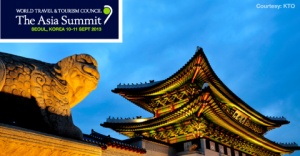WTTC Asia Summit: Spotlight on Seoul

South Korea saw its direct tourist economy grow by 10.4 per cent in 2012, according to figures from the World Travel & Tourism Council, making it the 11th fastest growing tourist economy in the world, and the fastest in Asia.
It is at the vanguard of a region which will dominate the tourism sector over the next decade, with China, Indonesia and India all set to grow significantly in their importance to global travel.
The issues to be faced in Asia will be those which command the attention of all the global players in the industry, as well as the political leaders of tourist economies worldwide.
The Asia Summit - which takes place on September 10th-11th at the Lotte Hotel in Seoul - will address what needs to be done to harness the enormous growth potential, in Korea and beyond, showcasing countries which are driving the industry with an enlightened approach, and drawing comparisons with positive and negative experiences in other parts of the world.
The summit provides the opportunity for a stimulating exchange between private and public sector, and it will tackle some of the most pressing issues facing tourism today.
The theme of the Asia Summit is ‘Staying Ahead of Tomorrow’.
This theme encapsulates the region’s global lead in technology development; consumer understanding across different cultures; planning ahead for infrastructure build; launching new product; and developing human capital.
The Asia Summit will be attended by some of the region’s most influential business leaders and decision makers, joined by speakers who will talk about global trends and key issues that impact from other parts of the world.
Here Breaking Travel News takes a look at what is on offer to guests visiting the WTTC Global Summit in Seoul.

Seoul
Among the many highlights of a visit to Seoul is the N-Seoul Tower a communication and observation tower located on Namsan Mountain in Central Seoul.
Marking the highest point in the city, it has the Teddy Bear Museum which is divided into two exhibition halls featuring Teddy Bears in models of Seoul attractions.
Nearby is the Korea Furniture Museum a private museum of Korean traditional wooden furniture, woodenwares and earthenwares. The museum owns more than 2,200 items and has 11 Korean traditional houses which were deconstructed from original places and reassembled in this site.
As a UNESCO World Heritage, Changdeokgung Palace is one of the five grand palaces built by Joseon Dynasty.
It was the most favoured palace of many Joseon princes and was regarded as ‘the most unique Korean palace in harmony with the nature and the landscape’.
It has also ‘The Secret Garden’ which was originally constructed for royal family and palace women.

Insadong Antique Street is connected with modern galleries and tea shops. It is famous for its unique item stores like Ssamji Street and other Korean traditional antique stores as well.
For the more adventurous a trip to Korean Demilitarised Zone, or DMZ, could be in order.
The zone was created following the Korean Armistice Agreement between North Korea, China and United Nations Forces at the end of Korean War.
A visit will include the Dora Observatory, Dora Station, and the Third Tunnel.
Finally, the National Museum of Korea is the flagship museum of Korean history and art in South Korea and is the cultural organisation that represents Korea.
It is divided into three floors with the first floor looking at prehistory and ancient history. The second floor covers calligraphy and painting, while the third is concerned with sculpture and crafts.
The first floor’s Silla Gold Crown and third floor’s Bangasayusang (Pensive Bodhisattva) are the two must-see items.

More Information
For more on the World Travel & Tourism Council Asia Summit head over to the official website.

